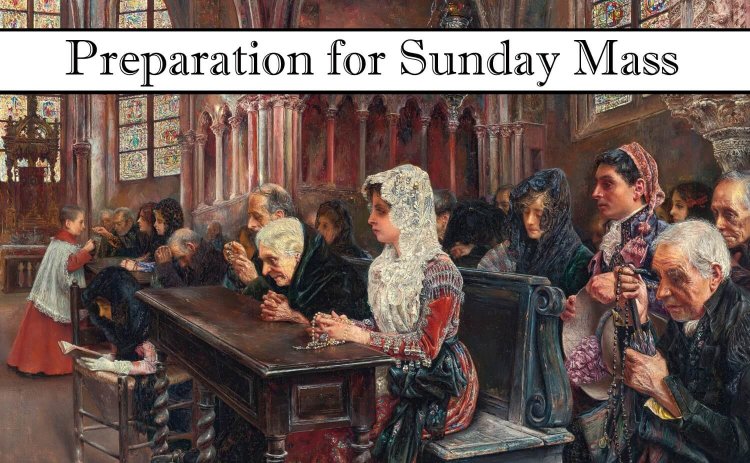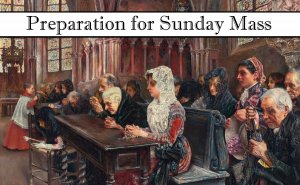We Are Going up to Jerusalem to Suffer
Context is important. We are in “Gesima” time, Pre-Lent, a time of preparation, for the time of preparation, for Easter. Holy Church, like our mothers, remind us that we have some chores coming due; she reminds us that Lent is […] The post We Are Going up to Jerusalem to Suffer appeared first on OnePeterFive.


Context is important. We are in “Gesima” time, Pre-Lent, a time of preparation, for the time of preparation, for Easter. Holy Church, like our mothers, remind us that we have some chores coming due; she reminds us that Lent is around the corner: after this “Fiftieth” Sunday, Quinquagesima, in three days is Ash Wednesday and the beginning of “Fortieth,” the season of Lent or Quadragesima.
A couple of weeks ago, we found that this period is also called “Shrovetide,” the time when you are “shriven,” that is, confessed and absolved of all your mortal sins in both kind and number. I mentioned that “shrove” is not only past tense of shrive (to absolve) but, because of context, it came to mean also “to party.” Hence, “Shrovetide” is in a more carnal way called “carnival,” from “carne-vale.” Latin vale is “good bye,” so “carnival” is “Goodbye meat!” This was the time, back when the Lenten discipline meant more than it means today, people were getting all the animal fats out of the house. Lent was a time of abstinence from meat and its related products for the whole season. Therefore, we have “Collop Monday,” for collops are slices of bacon. Gotta eat ‘em up because Lent is coming. There is a tradition of eating pancakes and the like on “Shrove Tuesday” also called “Fat Tuesday…. Mardi Gras.” Gotta use up those animal cooking fats before Wednesday. These days… fasting and abstinence? Puh-leez.
Bottom line: Lent is upon us. You do not have the excuse of being surprised. Go to confession. Figure it out.
More context. On these three Gesima Sundays before Lent, we lost the Alleluia which won’t revive until the Easter Vigil, we have penitential purple vestments, and the Sundays have Roman Stations, in order, St. Lawrence outside-the-walls, St. Paul outside-the-walls and, today, St. Peter on the Vatican Hill. In the Gospel reading from Luke 18 for Sunday, the Lord gives a prediction of His Passion, Death and Resurrection. Our trips, if only in spirit, to the Roman Stations is a journey with Jesus to the Passion. On Sunday we return with Peter to St. Peter’s, where his tomb is. You remember the story, I’m sure. Peter was afraid. He fled Rome. On the edge of the City, Peter met Christ, going into the City. “Quo vadis… Where are you going,” cried Peter. To Rome, “Romam eo iterum crucifigi… To Rome, to be crucified.” Rome is still crucifying priests, even today.
What are we doing this Sunday? We are going up to Jerusalem to suffer, continuing last week’s theme. Because of the Roman Stations and the brilliant readings and antiphons, our eyes are wide open.
Moreover, more context. Don’t fall into the trap of using the word, “liturgy” to mean Holy Mass. While Holy Mass is a liturgy, not all liturgies are Mass, just as with squares and rectangles. Another liturgy is in the Church’s “divine office,” which is read in the Breviarium Romanum and, in the Novus Ordo, the Liturgia Horarum. At the liturgy of Matins on Sunday we read about Abraham, who goes at God’s command to Mount Moriah (also known as Mount Sion… Jerusalem) to sacrifice his son Isaac, the physical manifestation of God’s promise to Abraham whose descendants would be as numberless as the stars. Abraham with Isaac, with the wood for the fire on his shoulders, symbolize and foreshadow Christ, going up Golgotha. Abraham is the priest and the sacrificial victim is Isaac. They go up the hill. Christ went up to Jerusalem to suffer and die, the perfect Sacrifice. Jesus is both priest and victim being sacrificed in His own Person.
The Gospel pericope, or cutting from Scripture, has its parallels in Matthew 19 and Mark 10. In Luke, Christ has in this chapter told various parables. The Lord was near Jericho. He encountered a blind man who kept shouting “Jesus, Son of David, have mercy on me!” People tried to silence him, but He persevered. The blind man was brought to Jesus, who asked him what he wanted. His sight, of course. Jesus returned his sight, saying “your faith has made you well.” In the account in Mark 10, we learn that the blind beggar’s name was Bartimaeus, or “son of Timaeus.” The parallel in Matthew 20 and in Luke 18 give no name. Given the timing of it all, Bartimaeus is the second blind man healed by Jesus as he went to Jerusalem via Jericho. That could explain why the blind beggar of Luke was shouting to Him, because He had heard of Him. And he believed. As the Angelic Doctor says, Ex auditu solo, tuto creditur.
Bartimaeus seems like a Gentile name with a Hebrew prefix. But there he was, outside the city, poor, blind, vulnerable shouting “Son of David,” the Messianic title” and, in the parallel version in Mark, he calls Jesus “Rabbuni… my teacher!”
One thing we can take away from this is the fact that, firstly, we are the learners and not the teachers. Christ, the Light, enlightens us. He brings us from spiritual blindness to insight. In Pre-Lent, this is accomplished through a thorough examination of God. Knowing who he is and what he isn’t, the blind beggar Bartimaeus asked for the miracle. He asked for it. God will work miracles, but we have to ask for them.
Another thing to take away comes from when we compare the version in Mark 10. The word “call” from Greek kaleo is repeated. Bartimaeus shouted, and Jesus responded “Call him.” And, in fine repetitive Jewish literary style, “call” is hammered home: “And Jesus stopped and said, “Call him.” And they called the blind man, saying to him, “Take heart; rise, he is calling you.” Greek kaleo is also where the word ekklesia, Church, comes from. In fact, Bartimaeus and the Lord were not alone. There were many people around. Those present, the close disciples of the Lord, probably Apostles, brought Bartimaeus to Christ. I imagine many people helping the blind man, not just one. There is a relay, and the blind man the baton, to be carried over the finish line: “Get this man to CHRIST!”
Note well that, “Take heart! He is calling you.” We are not alone in this. People will and can help. It is good to be able to stand on one’s own to feet and by capable. However, autonomy can close us in upon ourselves. We are not alone, especially in time of travail.
Thirdly, we can go forth on this Sunday before Lent with this in mind: to one extent or another we are all blind. But one day the veil will be pulled back, even ripped asunder and, eternal light will spotlight us, and we will see: everything will be laid bare before the Judge. The story of this blind beggar, reminds us that we are no one other than who we are, we have to know ourselves by introspection and examination, we are not alone in this vale of tears and we have duties to others and we must be willing also to ask for help, and lastly one day we will go before the Judge.
Let us not be so blind to our state that we do not look ahead and make some decision about where we want to be, both at the end of a good Lent, and at the end of our lives.
In this matter, Holy Church for centuries after centuries on this day read the famous, perhaps most famous, passage from the First Letter of St Paul to the Corinthians, 13. It is a good passage to read before making your examination of conscience
If I have all faith, so as to remove mountains, but have not charity (Greek agape, Latin caritas, sacrificial love), I am nothing.
The post We Are Going up to Jerusalem to Suffer appeared first on OnePeterFive.














